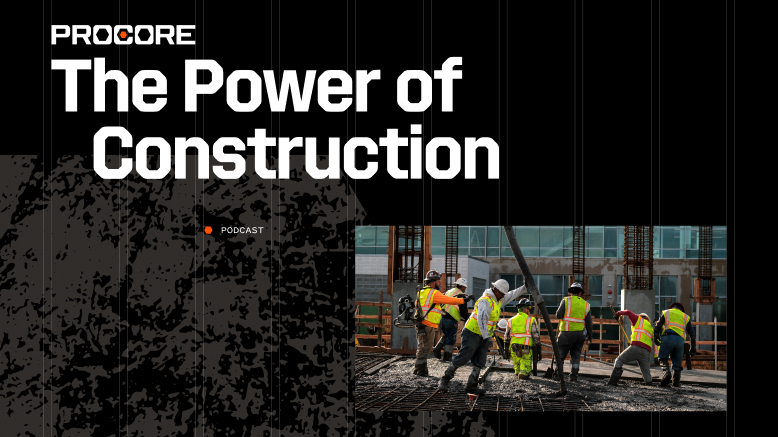— 11 min read
Bid Evaluation: Leveling the Playing Field


Last Updated Oct 3, 2025

Ben Ashburn
Staff Trainer & Program Manager
22 articles
Ben Ashburn is a Senior Construction Education Trainer at Procore. After a successful career as a construction estimator — working his way up from estimating manager to senior estimator — Ben has spent the most recent part of his career in construction sharing his skills with other as a construction educator. Ben has an extensive background in construction education: He has been an assistant professor in the Department of Construction Science at Texas A&M, and lectured about estimating, scheduling, management, and other related construction topics at Murray State University. He has been a construction training and learning development partner with Procore since 2019.

Kacie Goff
Contributing Writer
89 articles
Kacie Goff is a construction writer who grew up in a construction family — her dad owned a concrete company. Over the last decade, she’s blended that experience with her writing expertise to create content for the Construction Progress Coalition, Newsweek, CNET, and others. She founded and runs her own agency, Jot Content, from her home in Ventura, California.
Last Updated Oct 3, 2025

The bidding process is the portion of the preconstruction phase during which all of the seats at the table get filled. An owner sends out an invitation to bid (ITB) to find their general contractor, for example, and a GC accepts proposals to bring the specialty contractors they need on board. A strong bid and proposal evaluation process helps to seat the right parties around the figurative project table.
As part of the bidding process, key players — namely owners and general contractors (GCs) — need the ability to vet their options. Leveraging strong bid evaluation criteria gives them the highest possible level of confidence that they’re choosing the right teams for the job. Bid evaluation enables them to move forward with the contractor that can deliver on what’s most important to them — whether that’s price, quality assurance, or some other combination of factors.
Table of contents
Key Steps Surrounding Bid Evaluation
To best understand the bid evaluation process, it’s helpful to look at how it ties into the overall bidding process and the construction project management process. Here are the steps before, during and after bid evaluation.
Opening Up the Bid
Owners and general contractors won’t have any bids to evaluate if they don’t first solicit them. To open up the invitation to bid, they send out the bid package. This (ideally) gives contractors all of the information they need to not just send in accurate bids, but also to submit them formatted in a way to make bid evaluation easier. To accomplish that goal, the bid package might include specific forms that each bidder should fill out, for example.
A quick note about language: The terms “Invitation to Bid( ITB)” can sometimes be confused with “request for proposal (RFP)”, but these terms are not used interchangeably. The bid package going out with an RFP is more common when the party soliciting the bids will evaluate them on criteria other than price (i.e., use best-value or qualification-based selection, which we explore in more detail below).
To avoid confusion, this article uses ITB moving forward.
Bid Day: Submission of Bids
Once the ITB goes out, contractors start preparing their bid proposal. That doesn’t mean, however, that those get submitted promptly. In fact, it’s common practice for bids to come in at the last minute before the deadline. This is a specific time (e.g., 12 p.m. PT) on a specific date, called the bid day.
There are a few reasons contractors don’t necessarily submit their bids before the deadline.
For starters, GCs often collect their own bids from specialty contractors in order to price their bid proposal accurately. Those numbers might come in late — and if they do, GC teams want to have as much time as possible to evaluate those proposals and pick the number they want to include in their own bid.
Submitting bids close to the deadline also adds an element of savviness. Unethical owners and GCs might do bid shopping if they get those numbers early. That means they would take the number the contractor submitted in their bid and ask other contractors if they could beat it. Putting in a bid as close as possible to the bid-day deadline limits the potential of getting bid-shopped.
Even if they toe the deadline, it’s critical for contractors to get bids in by the bid-day deadline. Missing the deadline is usually grounds for immediate disqualification from consideration, often forcing decisions that are worth hundreds of thousands of dollars in the span of a couple of minutes.
Initial Screening
Once the deadline passes, the owner or GC starts evaluating the submissions. They perform an initial wave of bid evaluation. This first pass doesn’t get very far into the details of the bids. Instead, it’s simply making sure that the contractor ticked all of the required boxes. In short, did the contractor meet the minimum requirements to complete the bid?
If key form fields are left blank, for example, that bid might get dismissed. If the bid doesn’t provide bid security when that was required, it similarly doesn’t make it past this first phase.
While the bid evaluation criteria might be simple in this first phase, they’re firm. Owners and GCs will be quick to move unsatisfactory bids to the discard pile. The rationale goes that if the contractor can’t comply with the requirements of the bid, they’re unlikely to live up to the requirements of the jobsite.
Bid Leveling
This is where the meat of bid evaluation happens. We discuss different methodologies and bid evaluation criteria below, but no matter which measures the owner/GC uses, their goal is to level the bids. Different contractors have different bidding strategies and, as a result, details may come in formatted or communicated differently. Bid leveling means organizing the information in various bids so that the owner or GC can compare apples to apples.
Usually, this means comparing the bid proposal against the scope of work for the applicable CSI division. For example, a general contractor might make a scope sheet for all of the work to fulfill the concrete on the project. They then leverage the elements of that scope sheet to level all of the bids they received from concrete contractors.
Here’s an example of a GC leveling bids from three concrete contractors.
| Waugh Brothers | Elliott Concrete Co. | Ten One Five, Inc. | |
| Concrete (materials and labor) | $250,000 | $275,000 | $225,000 |
| Rebar (materials and labor) | Not included | $25,000 | $35,000 |
| Curb and gutter work | $50,000 | $45,000 | $55,000 |
| Safety requirements | Met | Met | Not met |
| Total Cost | $300,000 | $345,000 | $315,000 |
Note that the Waugh Brothers bid didn’t include pricing for the required rebar. In some cases, this might be enough to remove that subcontractor from the running.
In others, the decision-maker (in this case, the GC) may use what’s called a “plug number.” This is an amount the GC inserts into the missing slot, informed by market research, information from other specialty contractors, or another source. In this case, for example, they may use a plug number of $30,000 to fill in the missing rebar pricing. That would bring the Waugh Brothers total to $330,000.
Selection
After leveling, the bid and proposal evaluation process moves into its decision-making stage. The owner decides on the GC to award the contract, or the GC chooses the specialty contractor with which they want to move forward. It’s best practice to assemble a bid selection team rather than having a single person make the decision. This helps to prevent bias or favoritism.
Someone from the decision-making team reaches out to the chosen contractor with a notice of award, informing them that they’ve been chosen. That doesn’t mean, however, that everything is ironed out just yet.
Learn more about bid rigging in construction.
Negotiation
While it’s relatively rare to negotiate on price, the owner or GC might negotiate with their chosen contractor on things like scope of work or payment terms. Ironing out the details around working together ensures that they all get accurately captured in the contract, which then gets drawn up.
Awarding of the Contract
When writing the contract, the owner or GC’s team leverages the information the contractor provided in their bid. Once both parties sign on the dotted line, the project can move forward.
NOV 6, 2025 at 11:00 AM PST / 2:00 PM EST
Free Webinar: Prove your project management software is profitable
Join Procore and Dodge Data & Analytics for a 2025 Dodge ROI Report deep dive.

Methodologies for Bid Evaluation
In some cases, bid evaluation criteria hinge solely on price. In others, the decision-maker weighs soft factors like the contractor’s reputation, experience or safety record.
Generally, the bid evaluation methodology falls into one of three categories: price-based, best-value or qualification-based.
Price-Based Selection
Public projects (i.e., ones with government construction contracts) award the contract to the contractor who can perform the work for the lowest price. Most statutes will require that the contract goes to the “lowest responsive and responsible bidder.”
Responsive means that the contractor was able to complete all of the paperwork properly and on time. Responsible means that they have demonstrated competency in the work. To validate that, they often need to provide proof like financial records and a bid bond.
Dive Deeper: How to Be a Responsive, Responsible Bidder
To ensure that the process is fair, public projects usually require contractors to submit a sealed bid. This keeps the bid confidential until bid day.
Best-Value Selection
With this methodology, the bid evaluation criteria extend beyond price. The decision-maker might also look at the contractor’s
- Previous experience with similar projects
- Ability to put a certain team in place
- Financial records
- Certifications in certain technical areas
- Safety record
While a lot of bid recipients use a bid evaluation platform to evaluate these factors in a fair and balanced way, this can also be accomplished with a spreadsheet.
Whether they use a software or a spreadsheet, the bid recipient puts each bid evaluation criterion in a column, assigns a weighted average to that criterion, then scores the bidder on it. Totaling up the bidder’s score across all of the bid evaluation criteria enables the decision-maker to determine which party is most likely to best fit the project’s requirements.
As the name suggests, best-value selection takes price into account just as much as any of the soft bid evaluation criteria.
Qualification-Based Selection
If the owner is much more concerned with project outcomes — say, the project being completed by a specific date or meeting specialized safety requirements — they may weight other criteria well above price. With qualification-based criteria, the primary concern is about finding the right team for the project, not how much it will cost.
Still, though, the decision-maker should create a quantitative way to measure qualification-based criteria (like assigning them a weight average) to keep the bid evaluation process as fair as possible.
How to Overcome Challenges in the Bid and Proposal Evaluation Process
To avoid pitfalls when evaluating bids, owners and GCs need to work to avoid the following.
| Challenge | Description | Solution |
|---|---|---|
| Unclear ITBs | When contractors don’t have total clarity on what’s required for the project, their bids are likely to have more variance. Bid leveling gets harder and the decision-maker is likely to be faced with more scope gaps. If the ITB is vague, the plans or specs don’t provide a high level of detail, or the included forms are confusing to complete, bid evaluation gets more difficult from the very beginning. | Owners and GCs need to strive to create ITBs that don’t require contractors to guess or make assumptions when completing their bid. |
| Bias | While positive past experiences can certainly be a tick in the pro column for a contractor, decision-makers need to work to award the contract to the party that is the best fit for the project. Choosing a contractor based on bias could lead to higher-than-necessary pricing, lower-quality work, or both | To avoid biased decision-making, owners and GCs need to establish clear bid evaluation criteria and a scoring system that gets applied to all contractors in the same way. Having more than one person make the decision about who gets awarded the contract also helps to minimize the influence of any single individual’s bias. |
| Lack of leveling | Without a way to level bids, decision-makers are tasked with comparing apples to oranges. This makes it difficult to discern which contractor offers the best proposal for the specific project. | GCs and owners need to establish a clear, repeatable bid and proposal evaluation process that takes into account what’s most important for any given project, whether that’s price alone or price and a combination of soft factors. Bid leveling platforms can help here. |
| Bidder disputes | If bidders feel the bid evaluation process was unfair in any way, they can dispute the decision to award the contract. This opens the owner or GC up to the possibility of litigation. | Providing clear feedback to all contractors who submit a bid and being transparent about the bid evaluation criteria help to reduce the risk of bidder disputes. |
Ensuring Effective Bid Evaluation for Project Success
The bid evaluation process is essential for successful project management, requiring careful preparation and clear communication. Thoroughly understanding the project and engaging in discussions with specialty contractors can reduce the last-minute stress of bid day. Clear ITBs and effective bid leveling allow general contractors and project managers to make informed choices about the best teams for their projects.
When owners and GCs recognize potential challenges, they are motivated to develop strong, repeatable bid evaluation methods. These methods can be reused and improved over time for future projects. By taking these steps, decision-makers can ensure fair bid comparisons and make quick, confident choices, setting the stage for project success.
Was this article helpful?
Thank you for your submission.
100%
0%
You voted that this article was . Was this a mistake? If so, change your vote
Scroll less, learn more about construction.
Subscribe to The Blueprint, Procore’s construction newsletter, to get content from industry experts delivered straight to your inbox.
By clicking this button, you agree to our Privacy Notice and Terms of Service.
Thank you!
You’re signed up to receive The Blueprint newsletter from Procore. You can unsubscribe at any time.
Categories:
Written by

Ben Ashburn
Staff Trainer & Program Manager | Procore Technologies
22 articles
Ben Ashburn is a Senior Construction Education Trainer at Procore. After a successful career as a construction estimator — working his way up from estimating manager to senior estimator — Ben has spent the most recent part of his career in construction sharing his skills with other as a construction educator. Ben has an extensive background in construction education: He has been an assistant professor in the Department of Construction Science at Texas A&M, and lectured about estimating, scheduling, management, and other related construction topics at Murray State University. He has been a construction training and learning development partner with Procore since 2019.
View profile
Kacie Goff
Contributing Writer | Procore Technologies
89 articles
Kacie Goff is a construction writer who grew up in a construction family — her dad owned a concrete company. Over the last decade, she’s blended that experience with her writing expertise to create content for the Construction Progress Coalition, Newsweek, CNET, and others. She founded and runs her own agency, Jot Content, from her home in Ventura, California.
View profileExplore more helpful resources

What Happens When Data Drives the Business?
Construction has long been seen as a low-margin industry. But what if the real problem isn’t the margins—it’s how decisions get made? In episode 17 of The Power of Construction,...

Vet Contractors with Confidence: A Guide to Smart Bidder Selection
Selecting the right bidder is one of the most consequential decisions a construction team makes — yet it often happens under tight deadlines, with limited visibility into the long-term implications....

The Construction Bid Interview & Follow-up: Closing the Deal
During construction project bidding, the interview is often the last part of the request for proposal (RFP) process and one of the most influential. For teams that advance to the...
Construction Business Development: Tracking and Winning the Right Opportunities
Construction business development isn’t just a response to deadlines: It’s a long-term strategy rooted in focus, visibility and timing. Delays, funding gaps and market pressure have made it harder to...
Free Tools
Calculators
Use our calculators to estimate the cost of construction materials for your next project.
Templates
Find a template to help you with your construction project tasks.
Material Price Tracker
Get the latest U.S. retail prices and view historical trends for common building materials.
Glossary
Explore key terms and phrases used in the industry.
